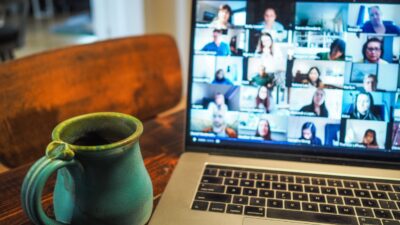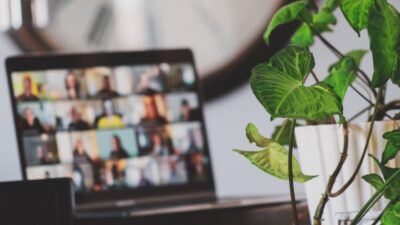Sandra Peter and Kai Riemer

9 things we learned about hybrid work
This week: we take stock and discuss nine important things we learned about hybrid work.
Sandra Peter (Sydney Business Insights) and Kai Riemer (Digital Futures Research Group) meet once a week to put their own spin on news that is impacting the future of business in The Future, This Week.
The stories this week
00:00 – Our hybrid working future isn’t going so smoothly
Other stories we bring up
Our previous discussions of remote work post-pandemic, hybrid work futures, remote work productivity and working from home on The Future, This Week
Atlassian goes on a flexible work recruitment drive
Goldman Sachs is going back to the office
Microsoft’s Annual Work Trend Index Report for 2022
Young workers are missing out on flexible hours
When teams set their own policies, employees do return to the office
McKinsey’s 2022 study on flexible work
EU, UK and US studies showing on average an 8% rise in working hours
Commuting is good for you, turns out
Adding walking to working from home
Our previous discussion of Zoom fatigue on Corona Business Insights
Our previous discussion on the importance of relationships with Marc Stears
Microsoft’s research on the effects of remote work on collaboration
MIT Sloan’s article on the loneliness of the hybrid worker
Neuroscience research on in-person interactions
Issues with returning to the office and work day mandates
Incentives to get workers back into the office
Follow the show on Apple Podcasts, Spotify, Overcast, Google Podcasts, Pocket Casts or wherever you get your podcasts. You can follow Sydney Business Insights on Flipboard, LinkedIn, Twitter and WeChat to keep updated with our latest insights.
Send us your news ideas to sbi@sydney.edu.au.
Music by Cinephonix.
Dr Sandra Peter is the Director of Sydney Executive Plus at the University of Sydney Business School. Her research and practice focuses on engaging with the future in productive ways, and the impact of emerging technologies on business and society.
Kai Riemer is Professor of Information Technology and Organisation, and Director of Sydney Executive Plus at the University of Sydney Business School. Kai's research interest is in Disruptive Technologies, Enterprise Social Media, Virtual Work, Collaborative Technologies and the Philosophy of Technology.
Share
We believe in open and honest access to knowledge. We use a Creative Commons Attribution NoDerivatives licence for our articles and podcasts, so you can republish them for free, online or in print.
Transcript
Disclaimer We'd like to advise that the following program may contain real news, occasional philosophy, and ideas that may offend some listeners.
Sandra So we should talk about some things we've learned about hybrid work, remote work.
Kai There's been lots of articles, the four things, the six things. We've counted at least seven, eight.
Sandra We should do nine things.
Kai Maybe 10?
Sandra Oh, that's too much.
Kai Let's do this.
Sandra Let's do this.
Intro From the University of Sydney Business School. This is Sydney Business Insights, an initiative that explores the future of business. And you're listening to The Future, This Week, where Sandra Peter and Kai Riemer sit down every week to rethink trends in technology and business.
Sandra So there was this article in Fortune Magazine about the return to office, compromises between workers and bosses and how this is creating a nightmare for middle managers. It was only one of the articles, that seemed to be springing up every week, with some learnings about hybrid work.
Kai There's an article about why it is so hard to get people back to the office. There's one that complains about presenteeism for younger workers.
Sandra There's the Atlassian article about encouraging people who have opted for a tree change.
Kai Or a sea change.
Sandra Or a sea change.
Kai To come and work for Atlassian. Even if you are living hours away from the office that Atlassian isn't actually using that much these days, which is the whole point.
Sandra But pretty much every single week, there seems to be something about hybrid work, about how no one's quite got it right, people urging people not to come back, people urging others to stay as flexible as possible. bankers asking people to come back full time to the office. Mixed messages everywhere.
Kai 3-2-2, 2-2-3, 4-2-1-, 1-2-4, or five days back, or all remote. No one seems to get it right. And there seems to be no one solution. And we're not saying that we have the solution. But we've learned a few things.
Sandra So here are the nine things we've learned about hybrid work.
Kai As we've done Corona Business Insights, The Future, This Week, and various other things. So number one:
Sandra Hybrid is not one thing.
Kai Now it's not one thing across different organisations, there are obviously different models. We've seen Goldman Sachs, everyone back to the office. Elon Musk, famously, we see on the other end Atlassian, working mostly remote and everything in between. But it's also not one thing within the same organisation, which is often overlooked.
Sandra Even in our organisation, there are teams that are back full time and in the office four or five days a week. And there are teams that come to the office maybe twice a month, mostly to have a bit of social time or have planning meetings, but the rest is fully remote.
Kai And anything in between, some teams leave it up to the individual. So you have some people always in the office, some people never in the office.
Sandra But lesson learned here. Hybrid is not one thing, meaning that every time you talk about hybrid you should clarify what do you mean by hybrid work?
Kai And at what level are we discussing it? Are we actually talking about the whole of organisation, and the mandate, for example that applies to everyone? Or are we talking about different parts of organisations where often different models are frankly required, because work is not the same across various areas of the business.
Sandra Number two:
Kai Individual inequalities. So not only is hybrid different across different parts of the organisation, but we've seen in many different studies over the past months that it is actually experienced very differently by different individuals, if you belong to different groups in the organisation.
Sandra And there are some very concrete findings here. First of all, hybrid work is experienced differently by managers and by subordinates, in that over 60% of leaders describe themselves as thriving in this flexible working from home, working remotely conditions. But when it comes to subordinates, they thrive a lot less than their bosses, almost 25% less than their bosses. And we'll include the links to all these studies in our shownotes. This is from the large Microsoft study that's been underway over the last couple of years. Microsoft has been researching their entire workforce and how they've experienced remote work, and then coming back to the office, and have made all their findings available. We'll put the links in the shownotes.
Kai There's also a study reported in the BBC this week, which says that 74% of executives surveyed say that they are able to work flexibly in terms of deciding their own work schedule, when they are going to work. Whereas only 24% of junior staff had the same flexibility when it comes to their time, and that is regardless of where they work from. So you might be working from home, but many junior workers because of the nature of the work or because it's mandated by their bosses have to actually work a fairly strict schedule, have to be online and reachable. So don't have that same flexibility of you know, running some errands in the middle of the day and then working some hours after dinner.
Sandra And these inequalities that are emerging both in the uptake and the outcomes of hybrid or flexible work accrue not only in terms of seniority, but also in terms of gender. And again, we'll include a link to a study from June this year that McKinsey did. And it showed that having more flexibility was especially positive for women. However, the same piece of research showed that men are more likely to be offered remote work and flexible work than women were. And women on the whole, were working much longer hours and much more than men were.
Kai And so one finding that we take away from this is that we mustn't average things out. So we mustn't believe in false averages because they do hide those different realities when it comes to seniority, when it comes to gender, for example. And we mustn't forget that there are still some individuals for whom neither going back to the office nor hybrid might be an issue. If you are immunocompromised, have certain rare diseases, you're still confined to the house. So even if the majority of workers might be going back to the office, organisations have to find models for some individuals that have to work from home, not by choice, but because they have to.
Sandra So what we need to say here is that it might not be possible to design fully inclusive systems. And that is something that we must grapple with, as much as we might try, it might be impossible to design something that is fully inclusive. So teams might have to be very explicit about what they choose to prioritise and to try to surface as many of these inequalities as possible to try to address them.
Kai Number three: the productivity paradox. Productivity is up and down at the same time.
Sandra Well it's up if you are an organisation, and it might well be down if you're a worker. Whilst before the pandemic we could prove quite conclusively that working from home improved worker productivity by quite a lot, it was in the order of about 13%. Company performance would be up by over 20% if people were working remotely.
Kai Some of the time that is.
Sandra In the last two years, we've seen that worker productivity on the whole has gone down, employees are working longer hours while they're at home, there was the whole conversation of working 9am-2pm and then again in the evening, our work days are much more fragmented. But on the whole productivity for the organisation hasn't gone down, people have found ways to achieve the same outcomes but taking longer hours.
Kai Just as a reminder, productivity is defined as output divided by input. So if you're the organisation, if you're a team leader, you might well see the same or higher output per staff member employed. But at the individual level that is often achieved by putting in longer hours by simply working more, which means the equation of output per input might well have gone down at the individual level, which has implications for work-life balance, and mental and physical wellbeing, for example.
Sandra And again, we'll include a number of studies from the European Union, from the UK, and from the US, showing that on average there was about an 8% rise in working hours, a lot of the time that was not spent commuting, people now spent working. So almost all of the savings in commuting time were now spent working. Also the time spent engaged with work activities measured as the time from when you sent your first email to your last email of the day, pointed to a lengthening of the workday across the board.
Kai So managers should be mindful of how they think about productivity, whether it's at the unit level where it might well be up or at the individual level where higher output might come at the expense of less work-life balance. So, awareness and conversations with individuals to discuss where and how to do what work is what's needed here.
Sandra Number four: the commute is not all bad. Seriously, the commute is not actually all bad. And the two of us have discussed the commute a number of times on the podcast, both when we were talking about the lack of commute during the lockdowns and also as we were coming back from the commute. And this was one of those really striking findings around remote work and flexible work, because before the pandemic, commuting was clearly negatively associated with wellbeing. There were all these studies showing that an additional 20 minutes commuting reduced wellbeing by as much as a 19% pay cut. So 20 minutes extra on the bus or the train on the way to work or in the car, people perceived it as bad as getting like an almost 20% pay cut.
Kai And that might still be the case. But equally, it was shown that having no commute at all is equally bad, because there is now less or no separation between what counts as work and what counts as leisure time. Meaning that being always connected, especially for knowledge workers, you might actually work all the time, not commute, but also not switch off. Therefore spend what was previously done commuting, actually just working.
Sandra So if you can, have a short commute to work, that seems to be great for wellbeing, it provides a separation between work and life. But it's also not big enough to have negative effects on people's wellbeing. And if you can't, if you are working from home, or if you choose to work flexibly or remotely, find some kind of ritual, some kinds of things that you can engage in to create that work-life separation. We've heard from a number of people who get dressed up, go for a walk around the house or around the block, and then sit down at their desk. People who, even if they are at home will take time to listen to a podcast, why not The Future, This Week, listen to a podcast or do something different before they sit down to work. They dress in their work clothes, even if they're doing it from home. So all these little things that can make a difference.
Kai Or they leave the house and go to a coffee shop, start work there, then walk back and continue work at home, but at least have a ritual that signals now is work. And equally, now work is actually over. Number five: Zoom fatigue is real.
Sandra And you may not only Zoom, but Microsoft Teams, Google.
Kai Whatever there is, yes, any video-based conferencing tool is necessary for doing certain types of meetings, it is important to have visual cues, facial expressions, but it's at the same time what is so exhausting about Zoom calls.
Sandra We've done a whole episode not long ago around Zoom fatigue and the effects of Zoom and how stressful it is for our minds and our bodies to be staring directly...
Kai At the wall of faces.
Sandra At the wall of faces, that it's the either fight response or mating response where people are that close. The fact that our brain is always on and trying to decipher these cues, many of which we can't get because we only see part of the body or part of the individual. So that is a lot more demanding on us in a meeting compared to a face-to-face environment. But that it is also necessary, it helps provide a little bit more context to what we do.
Kai But as with many things, it is good only in moderation. If you find yourself in an endless Zoom roulette, you press the red button, then the green button and you go from one wall of faces to the next wall of faces, you tire out much more quickly than if you were to spend your day in traditional meetings, as exhausting as that can be because they are your body posture can change your view can wander from one face to another more easily you can focus on other things without being seen on Zoom to not being engaged. So endless Zoom calls can be a real problem for concentration or cognitive drain.
Sandra So what can we do? Well, first up, think about the times when you don't actually need to do a Zoom call, and maybe just a phone call or an audio conversation is sufficient. You know the person quite well, the tasks that you're collaborating on does not require you to be looking at the other person. So maybe just make a phone call.
Kai Decide who is actually needed in the meeting and at what times. If you have an hour-long meeting, but you know that someone is only needed for 10 minutes, dial them in for those 10 minutes, but don't make them stare at the wall of faces for another 50 minutes.
Sandra And last but not least, try to maybe catch up in person. This might not be at work. This might be over a cup of coffee or over a walking meeting. But see if you can make that Zoom call an actual face-to-face meeting. Because besides being a great tool for collaboration and a great tool that enables flexibility, Zoom is actually not really good at building trust or at conveying nuanced emotions. So while you might be able to signal delight or outrage over Zoom, those subtle cues that then build trust between people cannot be easily conveyed over Zoom.
Kai Because, number six: social capital needs care. Networking actually needs the office. Think about introducing a junior colleague to the senior collaborator in the coffee shop that can be done by just waving someone over giving them a quick introduction. But you're not actually just patching someone in into a Zoom call, casually or informally. That's just not how things work.
Sandra Turns out, actually, you're not patching people in at all. Again, from this big Microsoft study, they had found that this shift to remote work or off-site work meant that the business groups, both the like the formal groups that they had, but also the informal communities within the organisations, have become both less interconnected, and much more siloed. Because we don't actually patch these people in, and we tend to shrink our network over time.
Kai And you don't bump into people at all. Because there is no corridor conversations walking from one meeting to another, you're not meeting your colleagues at the local coffee shop, which you might when you're in the same building. So a lot of these ad hoc, serendipitous conversations that happen naturally in the office environment, just do not take place.
Sandra And again, we'll include the research in the shownotes that showed how employees added fewer new collaborators as they move to remote work.
Kai And that's a particular problem for people who are new to the organisation. For new entrants who've just joined, many people who joined during the pandemic, who were sent a laptop found it very, very hard to make connections, to know who to ask informally when they had a problem, they spend way more time in wait lines with helpdesks, rather than being able to just draw on their colleagues quite naturally, because they simply didn't have the networks and they didn't have the opportunity to build those networks.
Sandra So what you need to do is take practical, proactive measures to make sure that people do develop these networks and acquire new collaborators and meet new people. And often that might mean physically going to the office.
Kai And to make sure that it's not just those people looking for connections go to the office, but that they actually meet those more senior colleagues that have more flexibility that might not need to come to the office as much.
Sandra Number seven: the loneliness of the hybrid worker. The lonely worker just got lonelier.
Kai And we'll put an article from MIT Sloan Management Review in the shownotes, which argues that people who work remotely sometime and go to the office sometime, actually have to be able to meet with the people they work with in those office settings. Just because someone goes to the office and works alongside strangers doesn't really give them a better work experience. In fact, the experience of feeling lonely might actually be aggravated.
Sandra And it's not just the social and professional isolation that we're talking about when we talk about the loneliness of the hybrid worker. Neuroscience research has actually shown that only in-person interactions triggers certain types of physiological responses, and neural responses that enable trust, and that the digital channels by which we engage, actually disrupt those. So your brain is just not producing the necessary chemicals that you might feel when you are in the presence of other people and you physically talk to other people.
Kai So two things we can do here. On the one hand, if going to the office is not an option, check in often with people ask them how they're doing.
Sandra Building little rituals in your teamwork, for instance, meeting up every morning and having a two word, how are you feeling? check-in, that will enable you to detect early on if people are really suffering and that you need to have some serious interventions.
Kai And if your team only works sometimes in the office, maybe find a way to coordinate being in the office together on those days to have those face-to-face contacts.
Sandra Because number eight: you're better off leaving it to the team. Turns out attendance in the office and what days you're supposed to come in doesn't have to be mandated, it seems to not make much of a difference whether we tell people want to come in or whether we let them decide.
Kai So research reported in a recent BBC article found that there wasn't much of a difference in whether companies mandated a return to the office, say three days a week, or whether they left it to coordinate flexibly to teams who would then come into the office in effect the same amount of time, but likely felt much better about it because rather than being in the office because you're told to do so, the team decides when it makes sense to be in the office. And there's an actual reason to mingle with your co-workers rather than just, you know, having bums on seats, so to speak.
Sandra Number nine: short-term gain, long-term pain, The social foundations of our organisations do seem to crumble slowly over time. Whether that's around the social capital that we've built, that is now being depleted. Whether that's about social capital just not being created because people do not meet other people. There are real long term costs associated with hybrid and remote work. And you should expect these costs to grow slowly but steadily over time.
Kai So the early successes and euphoria of being able to work remotely in the early stages of the pandemic have given way to frustration as companies have employee turnover, people leave, people join organisations, if you're not in the office together relationships do not emerge naturally. And that actually reminds me of this case study of old when in the 1900s, German Forstwirtschaft, basically, the economics around growing timber quickly got exported around the world and many countries cut down their native forests and planted monocultures of Norwegian spruces. They did really, really well initially for one or two generations. And then of course, they died off because all they did was living off the nutrients in the soil that weren't replenished because we didn't have a functioning ecosystem. So organisations need to make sure that they have a functioning environment that replenishes the social foundations of the organisation, relationships, informal contacts.
Sandra So when we measure the success of our hybrid or remote work, we should have some measures that look at longer term rather than immediate productivity measures or wellbeing in the moment, but ways in which we can capture how healthy the organisation is over time.
Kai So that's all nine learnings about hybrid work so far as the journey goes. Is that all we have time for today?
Sandra Maybe we should also tell them that Fridays are doomed.
Kai Fridays, gone. And that doesn't necessarily mean four-day work weeks, but many articles have made the point that the Friday in the office is pretty much a write-off.
Sandra Yep, Citigroup has deemed Friday's Zoom-free, KPMG has declared no camera Fridays, only...
Kai Not even thinking that anyone's in the office. But even cameras can be left off because no one's wearing pants on Fridays.
Sandra Exactly. A handful of people are only in on Fridays. So if you're planning for those meetings where you do get together, it's probably not going to be on Fridays. The studies show somewhere between 12 and 30% max of office workers swiping into work on, on Fridays, and many companies now moving to the four-day work week.
Kai And it is almost Friday where we are, so...
Sandra That is all we have time for today.
Kai Thanks for listening.
Sandra Thanks for listening.
Outro You've been listening to The Future, This Week from The University of Sydney Business School. Sandra Peter is the Director of Sydney Business Insights and Kai Riemer is Professor of Information Technology and Organisation. Connect with us on LinkedIn, Twitter, and WeChat. And follow, like, or leave us a rating wherever you get your podcasts. If you have any weird or wonderful topics for us to discuss, send them to sbi@sydney.edu.au.
Close transcript














